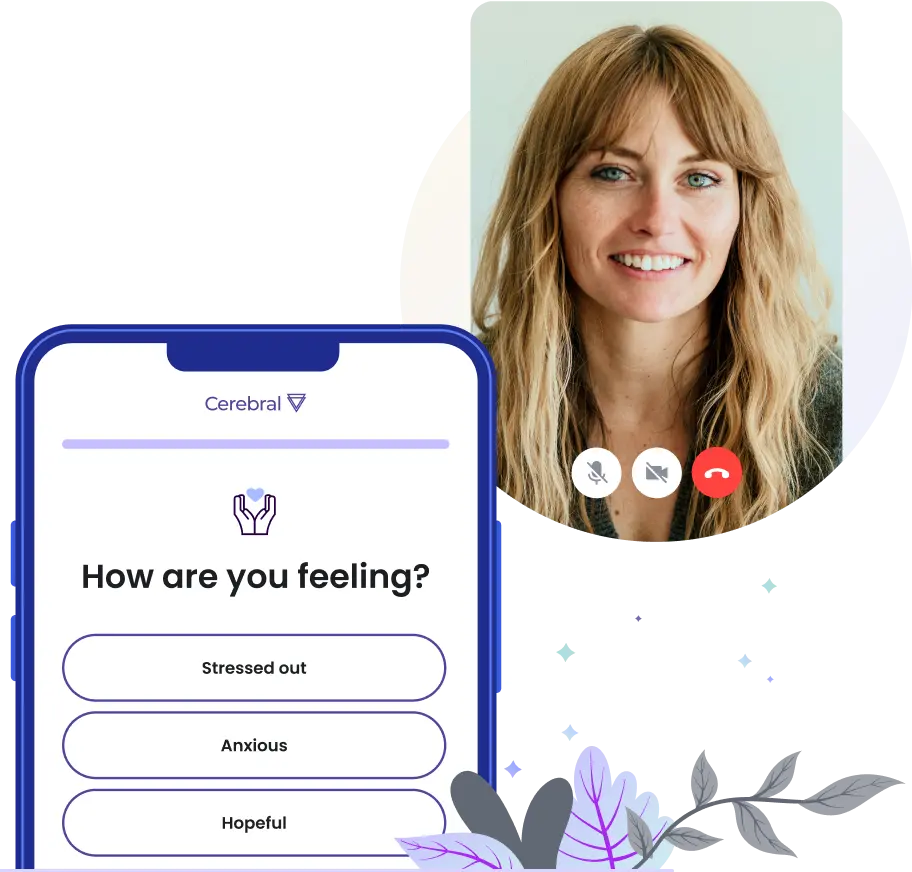Understanding the Different Types of Depression
Depression is a complex mental health condition that affects millions worldwide. While the terms ‘depression’ and ‘depressed’ are often used broadly, there are several distinct types of depressive disorders, each with its own set of symptoms and characteristics.
In short, despite its use as an umbrella term, depression isn't a one-size-fits-all diagnosis. Recognizing the variations in the types is one of the first steps in getting personalized support.
If you’re asking, “What kind of depression do I have?,” this general overview could help start you on the path to understanding. Here, we'll explore the various forms of depressive disorders and highlight their definitions, symptoms, and treatment options.
Whether you're struggling with your mental health or seeking to support a loved one, understanding the nuances of different depression-related disorders is crucial. Our goal is to help you gain awareness and turn that practical understanding into action. So, what is depression? Before we differentiate between its various forms and help you gain some clarity on how to tell what kind of depression you have, understanding what’s at depression's core is vital.
Depression is more than a fleeting state of sadness; it's an extended period of profound despondency and lack of interest in things that usually give you joy, excitement, pleasure, or happiness.
The biggest sign of a depressive disorder is a mix of symptoms that interfere with daily life and last for weeks or months, sometimes even years. Major depressive disorder (MDD) Major depressive disorder (MDD), also referred to as clinical depression and often conflated with just the term ‘depression,’ typically involves a persistent feeling of sadness, listlessness, and/or despondency and/or a loss of pleasure in hobbies or interests.
MDD is typically coupled with several additional symptoms, including changes in appetite, problems with sleep, and/or a loss of energy. Impacting more than just your mood, MDD can affect your ability to work, study, sleep, eat, and enjoy life. Symptoms of major depressive disorder At least one of these should be present almost every day: Depressed mood Diminished interest or pleasure in activities Several others will likely accompany the above symptoms of this depressive order: Significant weight loss when not dieting, or weight gain without attempting to do so Decreased need for sleep, or prone to oversleep Agitation or slowed movements Fatigue or loss of energy Feelings of worthlessness or guilt Diminished ability to think or concentrate, and indecisiveness Recurrent thoughts of suicide or death, or attempting suicide If you're thinking about acting on suicidal thoughts, reach out for help immediately. Call 911 if you’re having a mental health emergency. Text HOME to 741-741 if you're emotionally distressed and need immediate support. Call 988 for the National Suicide Prevention Hotline. {MiniWidget:Depression} MDD treatment options Treatment for MDD often involves psychotherapy, medication, or a combination of the two. Psychotherapy, such as cognitive behavioral therapy (CBT) or interpersonal therapy (IPT), can be highly effective, along with antidepressant medications.
Selective serotonin reuptake inhibitors (SSRIs) are often the first line of treatment, but for those with severe depression or who don't respond to other treatments, transcranial magnetic stimulation (TMS) or electroconvulsive therapy (ECT) may be considered. Persistent depressive disorder (PDD) What is persistent depressive disorder (PDD)? Also known as dysthymia, this condition is a low-grade, chronic depression that might not hinder someone but can prevent them from feeling a healthy balance of emotions or picturing life in an optimistic light. How does PDD differ from MDD? PDD is diagnosed when a depressed mood lasts for most of the day, for more days than not, for at least two years, along with additional depressive symptoms. While the symptoms of PDD may not be as severe as those of MDD, they can still have a significant impact on daily life as they are more long-lasting than those seen in MDD. Symptoms and long-term effects of PDD Similar to MDD, signs can include changes in appetite or weight, sleep disturbances, fatigue, and poor concentration. Its diagnosis tends to differ for these symptoms: Low self-esteem: Self-criticism or a strong feeling of inadequacy can be common. Appetite or sleep changes: People with PDD may sleep too much or too little, for instance. Hopelessness: People with PDD often have an overall feeling that nothing will ever get better. Low energy: Your whole body can feel heavy, and even small tasks are exhausting or take longer. Managing persistent depressive disorder Therapy and medication are commonly used treatments for PDD. Support groups can also be an invaluable resource, and understanding friends and loved ones can be, too.
Behavior changes — such as adding exercise to your daily routine, eating healthy, or practicing mindfulness — can also help relieve symptoms.
It’s important to note: The long-term nature of PDD may require ongoing management, coping strategies, and support. Bipolar disorder Bipolar disorder, formerly known as manic depression, is characterized by extreme mood swings that include emotional highs (mania or hypomania) and lows (depression). There are several types of bipolar disorder, including bipolar I and bipolar II. Bipolar I vs. bipolar II Bipolar I disorder involves periods of severe mood episodes from mania to depression. In this type, manic episodes last at least seven days or are severe enough to require immediate medical care. With bipolar II, hypomanic episodes alternate with depressive episodes that are more frequent and lengthy. Manic, hypomanic, and depressive episodes Manic episodes or hypomanic states can vary in intensity. Common signs include: Increased energy, activity, and restlessness Excessively ‘high,’ overly good, euphoric mood Extreme irritability Racing thoughts and talking very fast Reckless behavior Conversely, depressive states mirror symptoms of MDD, as outlined above. Managing bipolar disorder Mood-stabilizing medication is one essential component of managing bipolar disorder, but therapy (including CBT and family-focused therapy) and support groups can also be important parts of treatment plans.
Lifestyle adjustments, particularly getting regular sleep and moderating alcohol and drug use, can also play a role in reducing the likelihood of episodes.
Individuals with bipolar disorder will need to work closely with mental health professionals to manage their condition. Atypical depression Atypical depression is a subtype of MDD characterized by a specific response to positive events, known as ‘mood reactivity.’ Despite its name, atypical depression is common. What is atypical depression? Atypical depression can mean a lot of different things, but most often, it refers to a specific pattern of depressive symptoms. People with atypical depression can experience: Weight gain or increased appetite Excessive sleepiness A heavy sensation in the limbs An aversion to engaging in social situations Sensitivity to rejection Unlike clinical depression, people with this type of depression can experience temporary improvements in their mood in response to good news or positive events, though their mood may quickly darken later. Treatments and coping strategies Treatment may involve a combination medication, psychotherapy, lifestyle changes, and coping strategies. Individuals with atypical depression can also benefit from light therapy or CBT to alleviate social anxiety. Stress management techniques and a support system can also be valuable. Psychotic depression Also known as depressive psychosis, psychotic depression is a major depressive episode that is accompanied by psychotic symptoms, such as hallucinations or delusions.
These could be physical disturbances like changes in motor function or sensations such as pain, or they could include sensory deprivation where someone believes they have ceased to exist. Symptoms of psychotic depression This condition involves severe depression accompanied by psychotic features like: Delusions: False beliefs that aren’t based in reality. Hallucinations: Seeing or hearing things that aren’t there. Disorganized thinking or speaking: A loss of coherency in cognition or communication. Paranoia and fears: An overwhelming sensation of persecution, retribution, or impending harm, often accompanied by irrational beliefs or delusions of guilt, worthlessness, or inadequacy. It's important to recognize and treat psychotic depression promptly to prevent further complications. Diagnostic challenges and treatment options Diagnosing psychotic depression is complex as patients may be less likely to report symptoms that are frightening or perceived as shameful. For this reason, it’s important to find a judgment-free, comfortable space to speak with a trusted mental health professional about your perceptions and sensations. Additionally, psychotic symptoms may not be evident to others.
Once diagnosed, antidepressants and antipsychotic classes of medications, plus psychotherapy, are commonly recommended. Seasonal affective disorder (SAD) Seasonal affective disorder (SAD) is a type of depression that occurs at the same time every year, usually in the fall and winter. It's more than just the winter blues or cabin fever; SAD is a clinical diagnosis that can have severe impacts on one's life. What is SAD? Seasonal light changes heavily influence SAD, which disrupts the normal lives of people affected during the fall and winter months.
You may have seasonal affective disorder if you’re experiencing: A depressive mood most of the day, nearly every day, during specific seasons A loss of interest in things you once found pleasurable during the same period Seasonal weight gain or cravings for carbohydrates Sleeping more than usual or being lethargic during those seasons Difficulty concentrating during the same period Thoughts of death or suicide during certain seasons Treatment and preventive measures for SAD Light therapy, psychotherapy, medications, and, in some instances, supplements can help treat SAD.
Regular physical activity and socializing are also critical components of managing seasonal affective disorder. Perinatal (postpartum) depression Perinatal depression, commonly known as postpartum depression, is a significant depressive episode that occurs during pregnancy and/or after childbirth. It’s a serious but treatable condition that involves profound feelings of sadness, apathy, and/or anxiety. How it differs from the 'baby blues' While the 'baby blues' are common (it happens to up to 85% of all new birthing parents) and usually fade quickly, perinatal depression symptoms can be incredibly intense and have a significant impact on day-to-day living.
Symptoms of the 'baby blues' include unexplained crying, irritability, restlessness, and anxiety, and they often last for a week or two and generally resolve without intervention. Perinatal depression is emotionally and physically debilitating, could last for months, and requires treatment. Risk factors and perinatal or postpartum symptoms It’s estimated that up to 1 in 5 pregnant people go through perinatal depression. You may be more likely to experience this if you have: A history of depression or bipolar disorder Negative feelings toward the pregnancy Hormonal changes Sleep deprivation A baby in neonatal intensive care (NICU) Low estrogen and progesterone levels after delivery Signs to watch for include these perinatal (postpartum) depression symptoms: Difficulty bonding with the baby Sadness Anxiety Changes in sleep or meal patterns Intense irritability and anger Early intervention is key to recovery, and recognizing and treating this type of depression promptly is critical to support both your and your baby’s well-being. Treatment and support options Perinatal (postpartum) depression is typically treated with medication, counseling, or a combination of the two. Working with a qualified care team is incredibly valuable, as they can consider your and your baby’s specific needs.
Support from friends, family, and support groups can be essential in managing the symptoms as well as navigating a new development in life — whether it’s your first child or one of several. Situational depression Situational depression is an adjustment disorder with a depressed mood. This short-term condition occurs in response to a specific stressor or live event, such as an illness or death.
It can also occur following a significant life adjustment, such as job change, move, or divorce, or be triggered by a challenging situation like a legal battle, difficult relationship, or tumultuous work environment. Situational depression vs. MDD Some symptoms of situational depression can be the same as those seen in other depressive disorders, including changes in mood and behavior and physical symptoms like headaches or stomach issues. While it may share some specific similarities with MDD, the depressed state typically ends once the situation is resolved or you adjust to the life change or event.
In short, the biggest differentiating factor is that situational depression occurs after a specific event or stressor, whereas MDD can occur without any apparent trigger. Treatment and coping strategies With the support of friends, family, and/or a mental health professional, individuals can work through situational depression. It typically can’t be prevented, but healthy coping mechanisms, as well as self-care practices like exercise, proper nutrition, and mindfulness techniques, can help alleviate symptoms and promote overall well-being.
Coping strategies for situational depression may also include problem-solving techniques, stress management, and therapy. In some cases, medication may be prescribed to alleviate symptoms. The importance of understanding the types While the symptoms of various depressive disorders may overlap, each type has its own distinct features and treatment considerations. The sooner individuals understand what type of depression they are dealing with, the faster they can work toward a game plan to manage their symptoms.
If you're experiencing symptoms of depression, it's essential to seek help from a qualified mental health professional. Depressive disorders are treatable, and reaching out for support is a first step toward healing.
Whether you're unsure about your symptoms or seeking guidance on next steps, our licensed therapists and prescribers are here to help. Cerebral’s mental health professionals can help you manage your symptoms and improve your quality of life by offering individualized treatment plans, online therapy sessions, and ongoing support.
By educating yourself about the different types of depressive disorders and seeking personalized support, you can take control of your mental health. Am I depressed? Asking that question can be an initial step to finding answers and, more importantly, tailored support and interventions that address your unique needs.
To learn more about the level of your depression symptoms, take our 3-minute depression screener today.
Images by freepik, freepik, freepik, freepik, and Drazen Zigic on Freepik. The information in this blog is provided as a general educational resource only, and is not to be used or relied on for any diagnostic or treatment purpose. This information should not be used as a substitute for professional diagnosis and treatment and does not create any patient-physician relationship between you and Cerebral. Please consult your health care provider before making any health care decisions or to get guidance about a specific medical condition.
Read more





